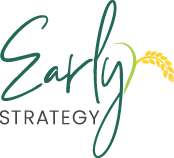How Do You Rally?
I am now* a big fan of campaigns. A good campaign effectively tells the story of a brand with a clear message, a goal, and a call-to-action. If a campaign is great, it will rally not only its external audience to action but internal colleagues as well. Whether we’re electing an official, fundraising for social impact, selling enterprise software, or promoting a movie (and more, of course), we use campaigns to rally.
I was particularly struck by the power of campaigns after watching Cesar Chavez a couple weeks ago.
Cesar Chavez lead the campaign to create the first farm workers’ union in California. To rally his internal organizers and external activists, they created the following supporting programs (at least, as depicted in the film):
- strikes (huelgas!)
- a grape boycott
- a march to California’s capital
- political cartoons and other leaflets
- Cesar Chavez’s hunger strike to ensure organizers remained non-violent
Eventually, all those efforts came together to exert enough financial pressure on the grape growers, and they negotiated a farm workers’ union. A great campaign!
charity:water is a good example of a brand with great campaigns. Every fall they launch their September Campaign to rally people to set up fundraising campaigns that support a particular water project. With beautiful multi-media content, their campaign tells the story of the receiving community’s struggle and hope. charity:water encourages individual fundraisers to organize their efforts around a campaign, like birthdays, running a race, growing a beard, etc.
How do you create a great marketing campaign?
Elements of a campaign:
A goal that supports your overall [business] objective
A clear message or story with a protagonist, antagonist, challenge, and proposed solution
A call-to-action
Programs are efforts you employ across relevant channels (media buys, SEO, emails, Twitter, strikes, etc.), and the tactics (ads, keyword optimization, subject lines, tweets, picket signs, etc.) are the particular details of how you tell the story.**
- Identify a particular [business] objective to support and define a goal (lead generation, sales, fundraising amount, social change, etc.).
- Research your target audience to understand their needs and how your product or service provides value for them.
- Create a messaging platform that guides effective communication across all programs and tactics.
- Determine the theme, or story, of your campaign and a clear call-to-action that supports your campaign’s goal (sign up, buy, donate, take action, etc.).
- Set a timeline.
- Choose the programs and channels where you will most effectively communicate with your audience. Some may be direct to call-to-action, others may be multi-touch with influencers and closers.
- Develop multi-media creative (text, images, video, audio, web pages, ads, tweets, etc.) that are consistent, beautiful, and effectively highlight your call-to-action.
- Execute and pay attention to every detail***.
- Evaluate performance part-way through and either continue the campaign as is or iterate.
Great campaigns also support the morale of a marketing team. Once you’ve rallied behind a successful campaign with proven results, you build upon that achievement in your next campaign!
What do you think? What’s your next rally?
*Starting in paid search, I had a very different relationship with campaigns. Paid search campaigns are high-level organization of keyword groups where you manage budgets, targeting, and the like. Most campaigns are always-on, and while I continually optimized for better performance, I didn’t see them as a rallying cry.
**Thanks to Jonathan Burg for this framework and my favorite explanation of campaigns, programs, and tactics.
***Execution is in the details!


